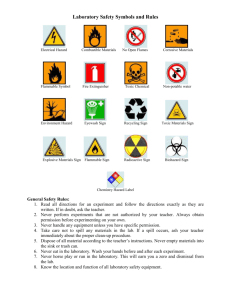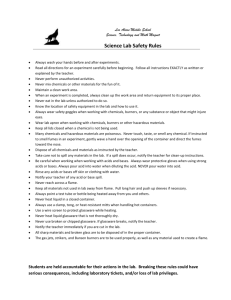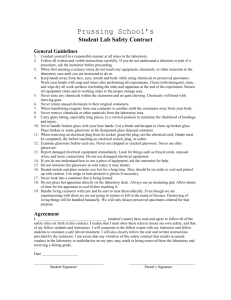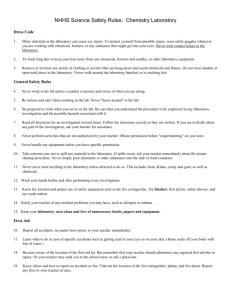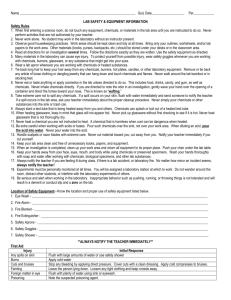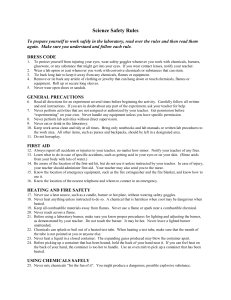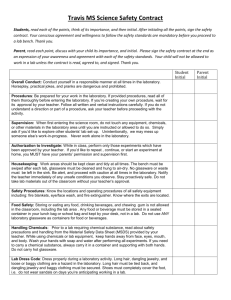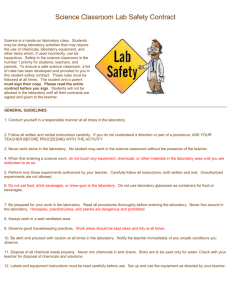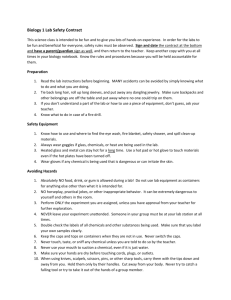Biology Lab Safety Rules Dress Code
advertisement
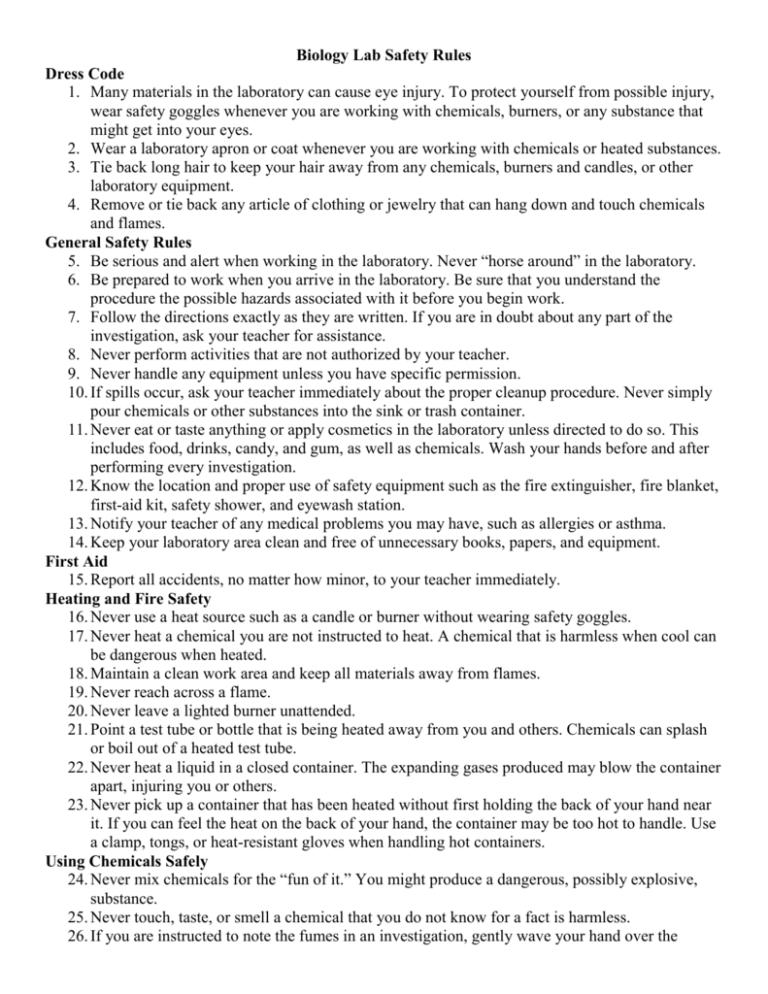
Biology Lab Safety Rules Dress Code 1. Many materials in the laboratory can cause eye injury. To protect yourself from possible injury, wear safety goggles whenever you are working with chemicals, burners, or any substance that might get into your eyes. 2. Wear a laboratory apron or coat whenever you are working with chemicals or heated substances. 3. Tie back long hair to keep your hair away from any chemicals, burners and candles, or other laboratory equipment. 4. Remove or tie back any article of clothing or jewelry that can hang down and touch chemicals and flames. General Safety Rules 5. Be serious and alert when working in the laboratory. Never “horse around” in the laboratory. 6. Be prepared to work when you arrive in the laboratory. Be sure that you understand the procedure the possible hazards associated with it before you begin work. 7. Follow the directions exactly as they are written. If you are in doubt about any part of the investigation, ask your teacher for assistance. 8. Never perform activities that are not authorized by your teacher. 9. Never handle any equipment unless you have specific permission. 10. If spills occur, ask your teacher immediately about the proper cleanup procedure. Never simply pour chemicals or other substances into the sink or trash container. 11. Never eat or taste anything or apply cosmetics in the laboratory unless directed to do so. This includes food, drinks, candy, and gum, as well as chemicals. Wash your hands before and after performing every investigation. 12. Know the location and proper use of safety equipment such as the fire extinguisher, fire blanket, first-aid kit, safety shower, and eyewash station. 13. Notify your teacher of any medical problems you may have, such as allergies or asthma. 14. Keep your laboratory area clean and free of unnecessary books, papers, and equipment. First Aid 15. Report all accidents, no matter how minor, to your teacher immediately. Heating and Fire Safety 16. Never use a heat source such as a candle or burner without wearing safety goggles. 17. Never heat a chemical you are not instructed to heat. A chemical that is harmless when cool can be dangerous when heated. 18. Maintain a clean work area and keep all materials away from flames. 19. Never reach across a flame. 20. Never leave a lighted burner unattended. 21. Point a test tube or bottle that is being heated away from you and others. Chemicals can splash or boil out of a heated test tube. 22. Never heat a liquid in a closed container. The expanding gases produced may blow the container apart, injuring you or others. 23. Never pick up a container that has been heated without first holding the back of your hand near it. If you can feel the heat on the back of your hand, the container may be too hot to handle. Use a clamp, tongs, or heat-resistant gloves when handling hot containers. Using Chemicals Safely 24. Never mix chemicals for the “fun of it.” You might produce a dangerous, possibly explosive, substance. 25. Never touch, taste, or smell a chemical that you do not know for a fact is harmless. 26. If you are instructed to note the fumes in an investigation, gently wave your hand over the opening of a container and direct the fumes toward your nose. Do not inhale the fumes directly from the container. 27. Use only those chemicals needed in the investigation. Keep all lids closed when a chemical is not being used. Notify your teacher whenever chemicals are spilled. 28. Dispose of all chemicals as instructed by your teacher. To avoid contamination, never return chemicals to their original containers. 29. Be extra careful when working with acids or bases. Pour such chemicals over the sink, not over your workbench. 30. When diluting an acid, pour the acid into water. Never pour water into the acid. 31. Rinse any acids off your skin or clothing with water. Immediately notify your teacher of any acid spill. Using Glassware Safely 32. Keep in mind that hot glassware will not appear hot. Never pick up glassware without first checking to see if it is hot. 33. Never use broken or chipped glassware. 34. If glassware breaks, notify your teacher. Do not put broken glassware in the trash. 35. Never eat or drink from laboratory glassware. 36. Clean glassware thoroughly before putting it away. Using Sharp Instruments 37. Handle scalpels or razor blades with extreme care. Never cut material toward you; cut away from you. 38. Be careful when handling sharp, pointed objects such as scissors, pins, and dissecting probes. 39. Notify your teacher immediately if you cut yourself or receive a cut. Handling Living Organisms 40. No investigations that will cause pain, discomfort, or harm to mammals, birds, reptiles, fish, and amphibians should be done in the classroom or at home. 41. Treat all living things with care and respect. Do not touch any organism in the classroom or laboratory unless given permission to do so. Many plants are poisonous or have thorns, and even tame animals may bite or scratch if alarmed. 42. Animals should be handled only if necessary. 43. Treat all microorganisms as if they were harmful. Use antiseptic procedure, as directed by your teacher, when working with microbes. Dispose of microbes as your teacher directs. 44. Clean your hands thoroughly after handling animals or the cage containing animals. 45. Wear gloves when handling animals. Electrical Safety Rules 46. Never use equipment with frayed cords. Make sure the cord is out of the way. 47. Never use electric devises near water. 48. Unplug the cord by pulling directly on the plug. 49. If electrical devices spark or get wet do not go near it. Push the red electric emergency button. End-of-Investigation Rules 50. When an investigation is completed, clean up your work area and return all equipment to its proper place. 51. Wash your hands after every investigation. 52. Turn off all burners before leaving the laboratory. Check that the gas line leading to the burner is off as well.
